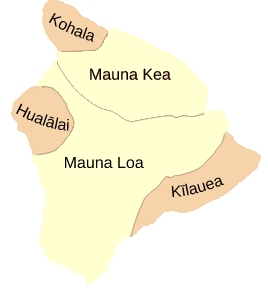|
Mauna Kea rises 4205 meters above the sea; but when measured from its base on the ocean floor, the mountain is over ten kilometers high, making it much taller than Mount Everest. Indeed both Mauna Loa and Mauna Kea would both be higher if not for the fact that they are so large that their combined weight depresses the ocean crust beneath them by 6 km. Mauna Kea slips (meaning ‘crushes itself under its own weight’) at a steady rate of about 0.2 mm per year. The volcano is estimated to be a million years old and last erupted about 5-6 thousand years ago.
The Hawaii hotspot is one of the best known and most studied tectonic hotspots on the planet. One of the largest projects undertaken in recent years has been the Hawaii Scientific drilling project (HSDP). This project was a collaboration between the University of California at Berkeley, the California Institute of Technology and the University of Hawaii. The principal objective was to obtain a better understanding of the geochemical and geophysical processes within the mantle plume of these volcanoes.
HSDP provided geologists with core samples from Mauna Kea from depths reaching 3255 meters. The rock samples recovered from the drill gave the scientists what is probably the longest continuous stratigraphic record from any ocean island volcano. This represented a unique opportunity to study a significant portion of the life history of a plume-related volcano.
Recent extensive tomographic studies (tomography being technique for displaying a representation of a cross-section through a solid object by use of X-rays or ultrasound) indicate that the plume which feeds the Hawaii hotspot is of lower-mantle origin. The plume material seems to originate from a thin low-velocity zone at depths of 1500 km beneath Hawaii. This connects with a large low-velocity zone at the core-mantle boundary to the north of Hawaii. The tomographic data indicates that the hotspot over which the Pacific plate is passing is about 500-600 km wide.
The most recent project, published in Nature Geoscience, carried out detailed isotopic analyses of 120 volcanic samples; comparing samples from both Mauna Kea and Mauna Loa. A method for dating rock samples called the ‘lead-lead’ method was used. That is, a comparison between two lead isotopes (206Pb and 204Pb) which decompose at different rates allows scientists to determine the age of a sample. The volcanic samples studied here showed that Mauna Loa has a 206Pb/204Pb ratio between 18.05 and 18.26. This is distinct from the Mauna Kea lavas which had a higher 206Pb/204Pb ratio. This data means that Mauna Loa and Mauna Kea are distinct volcanoes, with only three samples from Mauna Loa crossing the boundary and merging the two eruptions.
The authors conclude that Hawaii’s two main volcano chains, the Loa and Kea trends, have distinct sources of magma and unique and separate plumbing systems connecting them to the Earth’s deep mantle. This study is the first to conclusively link surface lava composition with differences in the deep mantle from which it originates. The existence of such different chemistry in tectonic hotspot lavas allows a novel way to study mantle evolution.
Journal Reference:
Dominique Weis, Michael O. Garcia, J. Michael Rhodes, Mark Jellinek, James S. Scoates. Role of the deep mantle in generating the compositional asymmetry of the Hawaiian mantle plume. Nature Geoscience, 2011, 4, pp 831–838.
| 
